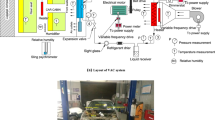Abstract
OVC-HEVs typically use the NIRCO systems to achieve their unique evaporative emission control strategies. This paper constructs the following OVC-HEV evaporative emissions calculation model: Based on the Clausis-Clapeyron equation and the ideal-gas equation, the pressure changes inside the sealed fuel tank and the evaporative emissions of fuel tank vapors are described; Then describe the adsorption and desorption equations of the carbon canisters through the results of the bench tests, and obtain its relationship with the initial working capacity and effective volume of the carbon canisters. Finally, based on the above sections, a NIRCO system evaporation emission calculation model for OVC-HEV is obtained, as well as a quantitative analysis of various influencing factors. Based on statistical data such as local climate temperature and driver usage, this model can be used to estimate the evaporative emissions of OVC-HEV fleets.
Access this chapter
Tax calculation will be finalised at checkout
Purchases are for personal use only
Similar content being viewed by others
References
Ministry of Environmental Protection, Administration of Quality Supervision, Inspection and Quarantine. Limits and measurement methods for emissions from light duty vehicles (China 6). China Environmental Science Press, Beijing 2016
Reddy, S.: Understanding and Designing Automotive Evaporative Emission Control Systems. SAE 2012 International Powertrains, Fuels & Lubricants Meeting. https://doi.org/10.4271/2012-01-1700
Mellios, G., Samaras, Z.: An empirical model for estimating evaporative hydrocarbon emissions from canister-equipped vehicles. Fuel 15(86), 2254–2261 (2007)
Mellios, G., Samaras, Z., et al.: A vehicle testing programme for calibration and validation of an evaporative emissions model. Fuel 88, 1504–1512 (2009)
Yamada, H.: Contribution of evaporative emissions from gasoline vehicles toward total VOC emissions in Japan. Sci. Total. Environ. 449, 143–149 (2013)
Yamada, H., et al.: Estimation of refueling emissions based on theoretical model and effects of E10 fuel on refueling and evaporative emissions from gasoline cars. Sci. Total Environ. (622–623), 467–473 (2018)
Yamada, H., Inomata, S., et al.: Evaporative emissions in three-day diurnal breathing loss tests on passenger cars for the Japanese market: Evaporative emissions in three-day diurnal breathing loss tests on passenger cars for the Japanese market. Atmos. Environ. 107, 166–173 (2015)
Hata, H., Yamada, H., et al.: Estimation model for evaporative emissions from gasoline vehicles based on thermodynamics. Sci. Total. Environ. 618, 1685–1691 (2018)
Dong, X., Fu, J.S., et al.: Modeling cold soak evaporative vapor emissions from gasoline-powered automobiles using a newly developed method. Air Waste Manag. Assoc. 12(68), 1317–1332 (2018)
Romagnuolo, L., Yang, R., et al.: Physical modeling of evaporative emission control system in gasoline fueled automobiles: a review. Renew. Sustain. Energy Rev. 116, 109462 (2019)
Yue, T., Wang, M., Huang, Z., et al.: Characteristics of evaporative emissions from light-duty vehicles and effects of ambient temperature on evaporative emissions of light-duty vehicles. Res. Environ. Sci. 33(1), 73–81 (2020)
Liu, D., Zhong, X., et al.: Uncontrolled refueling emission prediction model of gasoline vehicles. J. Tianjin Univ. Technol. Educ. 31(1), 23–27 (2021)
Wang, W., Zhao, J., et al.: Development of evaporative emission control system to meet China VI. Small Internal Combustion Engine Vehicle Tech. 50(3), 63–68 (2021)
Wang, H.: The analysis and selection between enclosed and opened fuel tanks in plug-in hybrid electric vehicle. Auto Sci-Tech. 1(009), 46–51 (2016)
Dong, X., Tschantz, M., et al.: Estimating evaporative vapor generation from automobiles based on parking activities. Environ. Pollut. 202, 104–111 (2015)
Author information
Authors and Affiliations
Corresponding author
Editor information
Editors and Affiliations
Rights and permissions
Copyright information
© 2024 The Author(s), under exclusive license to Springer Nature Singapore Pte Ltd.
About this paper
Cite this paper
Yin, J., Gong, B., Wang, K., Hu, J., Xu, H. (2024). Estimation Model for Evaporative Emissions from the Nirco System of OVC-HEV. In: Proceedings of China SAE Congress 2023: Selected Papers. SAE-China 2023. Lecture Notes in Electrical Engineering, vol 1151. Springer, Singapore. https://doi.org/10.1007/978-981-97-0252-7_66
Download citation
DOI: https://doi.org/10.1007/978-981-97-0252-7_66
Published:
Publisher Name: Springer, Singapore
Print ISBN: 978-981-97-0251-0
Online ISBN: 978-981-97-0252-7
eBook Packages: EngineeringEngineering (R0)




